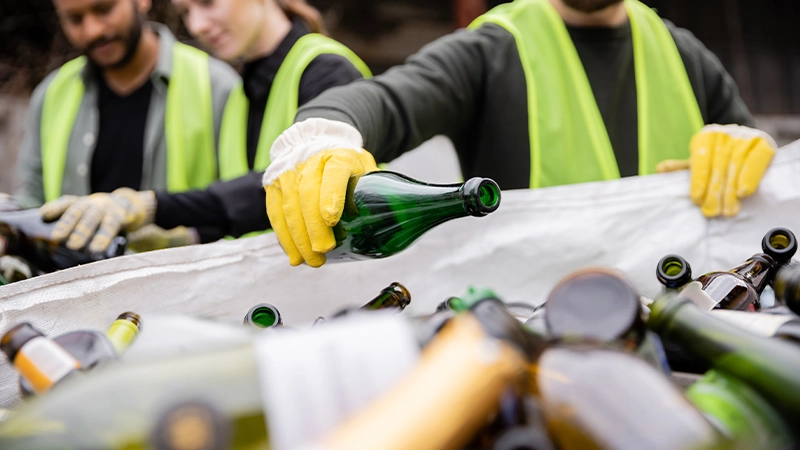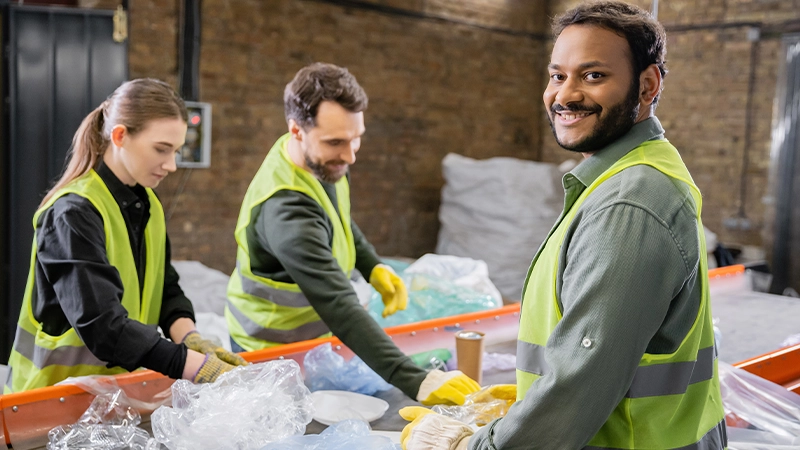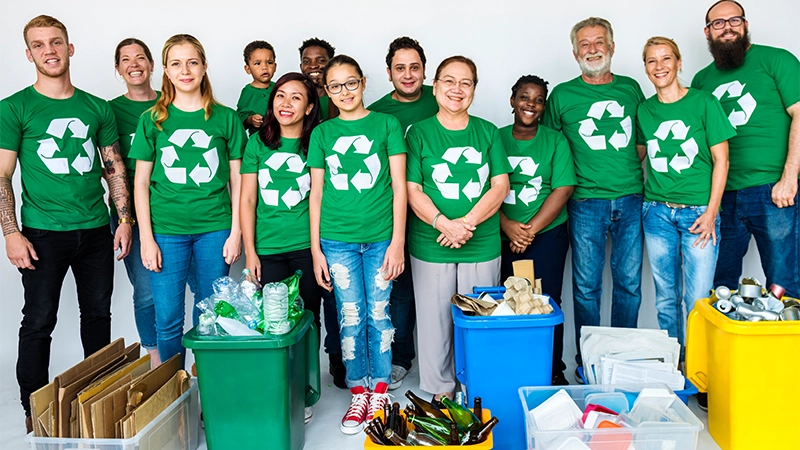What is Recycling – Today we face serious problems such as environmental pollution, depletion of natural resources and climate change. One of the most effective ways to contribute to solving these problems is recycling. So, the question “what is recycling?” helps us understand why this concept is so important for our environment and our future. In this article, we will take a comprehensive look at what recycling is, its importance, how it works and how it will evolve in the future.
Table of Contents
- Importance of Recycling
- How Does Recycling Work?
- Recycling Types and Examples
- Environmental Impacts of Recycling
- What are the Products of Recycling?
- The Future of Recycling
- Conclusion
- Frequently Asked Questions
Importance of Recycling
What is Recycling – Recycling reduces environmental pollution and conserves natural resources. It plays a critical role for a sustainable future. Recycling waste reduces the amount of raw materials used in new products. This helps conserve natural resources. Recycling saves energy – recycled materials require less energy to process.
These reasons increase the importance of recycling on a global scale.
The economic benefits of recycling cannot be ignored either. It creates new job opportunities, strengthens the local economy and supports sustainable business models. It also contributes to cleaner and more livable cities by improving waste management systems.

How Does Recycling Work?
What is Recycling – Recycling is the collection, sorting, cleaning, processing and recycling of waste materials into new products. This process is meticulously planned to ensure efficient use of resources and reduce environmental impacts. In general, it consists of the following steps:
Collection
The waste recycling process starts with the collection of waste materials from households, workplaces and collection points. At this stage, the correct separation of recyclable waste is critical for the process to proceed efficiently. Waste is collected through collection systems organized by local authorities or services provided by private companies.
Decomposition
The collected wastes are sorted according to their types. At this stage, the waste is sorted into different categories such as paper, plastic, glass, metal and organic waste. In modern facilities, in addition to manual sorting, automated systems and artificial intelligence-supported machines are used to classify waste faster and more accurately.
Cleaning
The sorted materials proceed to the cleaning stage. This step removes impurities such as dirt, oil and labels from waste materials. For example, plastic waste is washed to remove dirt and chemicals; glass crumbs are cleaned again. The cleaning process positively affects the quality of the final products by improving the quality of recycling.
Processing
The cleaned materials are sent to processing plants. Here, each type of material is processed in its own way:
Paper: Pulped and processed in paper mills to be used in the production of new paper.
Plastic: Shredded, melted and granulated; these granules are used as raw materials for the manufacture of new plastic products.
Glass: Broken glass shards are re-melted and turned into new glass products.
Metal: Melted and purified into raw materials that can be reused.
Electronic waste: Shredded to recover the valuable metals and plastics they contain.
New Product Production:
Raw materials obtained as a result of processing are directed to production lines. Furniture is produced from recycled plastic. New fabrics are made from textiles, and glass is transformed into construction or decoration products. This stage is part of the circular economy. Waste is recycled and enters a continuous cycle of use.
Each step is carried out with great care as it determines the efficiency of the process and the quality of the product. The recycling process conserves natural resources while eliminating waste.
It saves energy and creates products with high economic value.
In this way, an important step is taken for a sustainable environment and future.
Recycling Types and Examples
Recycling processes vary according to different types of materials. Each material has its own characteristics and recycling methods. The most common types of recycling are as follows:
Paper Recycling: Old newspapers, magazines and cardboard are mixed with water and pulped to make new paper products.
Plastic Recycling: Plastic wastes are separated according to their types and melted into new plastic products.
Glass Recycling: Glass bottles and other glass products are broken and remelted into new glass products.
Metal Recycling: Metals such as aluminum and steel are collected, melted down and used to produce new metal products.
Electronic Waste Recycling: Used electronic devices are dismantled and valuable metals and plastics are recovered.
The recycling process for each type is optimized according to the nature of the material, creating a sustainable cycle of use.
Environmental Impacts of Recycling
Protection of Natural Resources
Recycling reduces the need to extract new raw materials. This minimizes environmental damage such as cutting down forests, opening mines and extracting other natural resources. For example, the use of recycled paper contributes to the preservation of biodiversity by preventing the felling of trees. Likewise, recovered metals prevent damage to ecosystems through reduced extraction of natural resources.
Energy Saving
Recycling significantly reduces energy consumption. Producing new materials requires much more energy than producing from recycled materials. Recycling materials such as plastics, glass and metals requires much less energy than producing them from scratch. This plays an important role in combating climate change by reducing fossil fuel consumption and thus greenhouse gas emissions.
Reducing Carbon Footprint
Recycling reduces our carbon footprint. Processing waste and extracting new materials is energy intensive. Large amounts of carbon dioxide are emitted during these processes. Using recycled materials reduces energy requirements. This reduces greenhouse gases released into the atmosphere.
This helps to slow down global warming.
Reducing the amount of waste
Recycling reduces the need for landfill space and the accumulation of waste in landfills. Waste recovery reduces the amount sent to final disposal facilities, which optimizes land use and prevents environmental pollution. Waste accumulated in landfills is prevented from releasing harmful gases such as methane gas. It also makes it easier to tackle environmental problems such as pollution of soil, water resources and air.
Protection of Water Resources
Recycling processes reduce water use during production stages. Compared to products made from new materials, recycling uses less water. The use of recycled raw materials, especially in the paper and textile sectors, contributes to the protection of water resources. In addition, water pollution that may occur as a result of improper management of wastes is prevented.
Protection of Ecosystems and Biodiversity
Recycling preserves the balance of nature and prevents damage to ecosystems. As long as new mines are not opened and new forests are not cut down, animal and plant species continue to live comfortably in their natural habitats. This helps preserve biodiversity. A sustainable environment is created without disturbing the ecological balance.
These effects show that recycling is indispensable for environmental protection both locally and globally.

What are the Products of Recycling?
The products obtained as a result of recycling can be used in many different sectors. Here are some examples:
Paper Products: New notebooks, cardboard boxes, newspapers and books are produced from recycled paper.
Plastic Products: Furniture, toys, packaging materials and construction materials are made from recycled plastic.
Glass Products: Reprocessed glass is recycled into glass bottles, windows and decorative products.
Metal Products: Various products such as automotive parts, construction materials and household goods are produced from aluminum and steel.
Textile Products: Old clothes can be recycled into insulation materials, cleaning cloths or new fabrics.
Electronic Parts: Used electronic devices are dismantled and circuit boards and precious metals are recycled.
These products demonstrate that the recycling process has been successful and has brought great economic and environmental benefits.
The Future of Recycling
The recycling sector is constantly evolving and will become even more important in the future. While technological innovations increase the efficiency of the process, new methods are being developed to increase recycling rates.
Advanced Technologies: Intelligent waste collection systems, artificial intelligence-supported sorting machines and biotechnology make recycling processes more efficient.
Circular Economy: Projects aiming not only to recycle waste but also to prevent waste generation by producing with circular economy principles from the design stage are increasing.
Policies and Laws: Governments are developing environmentally friendly policies, leading to the implementation of regulations that will increase recycling rates.
These innovations will help make recycling a more sustainable, effective and widespread practice in the future.

Conclusion
Recycling is a process of great environmental, economic and social importance. By recycling our wastes, we both protect nature and work for a sustainable future. Knowing the processes of recycling, understanding its types and environmental impacts enables us to act more consciously individually and socially. Recycling, which will become more efficient with technology and innovations in the future, is an important step that will improve the quality of life for all of us.
Thanks to recycling, we can achieve many benefits such as protecting natural resources, saving energy and reducing the amount of waste. Therefore, we should all contribute to the environment by supporting recycling in our daily lives.
Frequently Asked Questions
Recycling is important to conserve natural resources, save energy and reduce the amount of waste. It also provides economic benefits and reduces environmental pollution.
It involves collecting, sorting, cleaning, processing and transforming waste into new products.
Many materials such as paper, plastic, glass, metal, electronic waste and textiles can be recycled
There is a wide range of recycled products such as paper, plastic items, glass products, metal parts and textiles.
It provides significant environmental benefits such as conservation of natural resources, energy savings, reduced carbon footprint and reduced waste.
Advanced technology applications such as AI-supported sorting systems, smart waste collection solutions and biotechnological methods are used in recycling.

